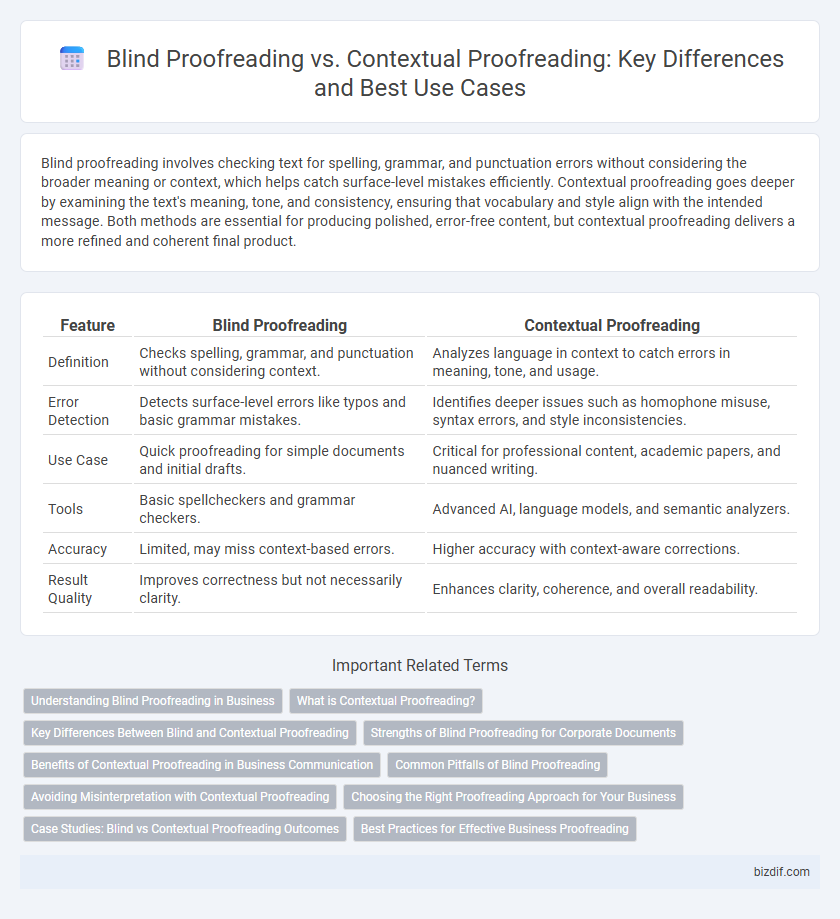Blind proofreading involves checking text for spelling, grammar, and punctuation errors without considering the broader meaning or context, which helps catch surface-level mistakes efficiently. Contextual proofreading goes deeper by examining the text's meaning, tone, and consistency, ensuring that vocabulary and style align with the intended message. Both methods are essential for producing polished, error-free content, but contextual proofreading delivers a more refined and coherent final product.
Table of Comparison
| Feature | Blind Proofreading | Contextual Proofreading |
|---|---|---|
| Definition | Checks spelling, grammar, and punctuation without considering context. | Analyzes language in context to catch errors in meaning, tone, and usage. |
| Error Detection | Detects surface-level errors like typos and basic grammar mistakes. | Identifies deeper issues such as homophone misuse, syntax errors, and style inconsistencies. |
| Use Case | Quick proofreading for simple documents and initial drafts. | Critical for professional content, academic papers, and nuanced writing. |
| Tools | Basic spellcheckers and grammar checkers. | Advanced AI, language models, and semantic analyzers. |
| Accuracy | Limited, may miss context-based errors. | Higher accuracy with context-aware corrections. |
| Result Quality | Improves correctness but not necessarily clarity. | Enhances clarity, coherence, and overall readability. |
Understanding Blind Proofreading in Business
Blind proofreading in business involves reviewing documents without prior knowledge of the original content to identify errors objectively and ensure accuracy. This method helps spot typographical, grammatical, and formatting mistakes by focusing solely on the text, reducing bias linked to familiarity. Employing blind proofreading enhances document reliability and professionalism, critical for contracts, reports, and marketing materials.
What is Contextual Proofreading?
Contextual proofreading involves reviewing a text to ensure clarity, coherence, and accuracy within the context of the subject matter, rather than simply checking for spelling and grammar errors. It prioritizes understanding the intended meaning, tone, and style to maintain the original message's integrity. This method helps identify nuanced mistakes such as incorrect word usage, awkward phrasing, and factual inconsistencies that blind proofreading might overlook.
Key Differences Between Blind and Contextual Proofreading
Blind proofreading involves reviewing text without prior knowledge of the content, focusing solely on surface errors like grammar, punctuation, and spelling. Contextual proofreading, however, requires understanding the meaning and flow of the text to identify issues related to word choice, consistency, and overall coherence. The key difference lies in blind proofreading targeting mechanical accuracy, while contextual proofreading emphasizes semantic accuracy and alignment with the intended message.
Strengths of Blind Proofreading for Corporate Documents
Blind proofreading enhances corporate document accuracy by eliminating cognitive bias, ensuring that errors are identified without preconceived context affecting judgment. This method improves consistency across legal, financial, and marketing materials by focusing solely on grammatical and typographical correctness. Corporate documents benefit from blind proofreading's ability to catch subtle mistakes that contextual familiarity might overlook, thereby maintaining professionalism and clarity.
Benefits of Contextual Proofreading in Business Communication
Contextual proofreading enhances business communication by ensuring that the text aligns with the intended message, tone, and industry-specific terminology, reducing misunderstandings and fostering professionalism. It identifies subtle errors related to word choice, jargon, and context that blind proofreading often misses, improving clarity and brand consistency. This method ultimately supports more effective client engagement and strengthens corporate reputation.
Common Pitfalls of Blind Proofreading
Common pitfalls of blind proofreading include missing contextual errors such as homophones, misused words, and awkward phrasing that disrupt clarity and meaning. Without understanding the context, proofreaders often overlook inconsistencies in tone, style, and factual accuracy, leading to subpar text quality. This approach can result in overlooked grammar issues that depend on sentence structure, reducing the overall effectiveness of the proofreading process.
Avoiding Misinterpretation with Contextual Proofreading
Contextual proofreading enhances accuracy by analyzing the meaning and intent behind the text, reducing the risk of misinterpretation that often occurs in blind proofreading where errors are spotted purely by surface-level review. It identifies homonyms, idiomatic expressions, and domain-specific terminology, ensuring the content maintains its intended message and clarity. This method significantly improves text coherence and reader comprehension by verifying that word choice and structure align with the surrounding context.
Choosing the Right Proofreading Approach for Your Business
Selecting the appropriate proofreading method depends on your business needs and document complexity; blind proofreading ensures error detection without bias, ideal for straightforward content, while contextual proofreading enhances meaning and coherence, essential for nuanced or technical texts. Businesses handling specialized terminology or industry-specific language benefit from contextual proofreading experts familiar with the subject matter. Evaluating factors such as deadline, budget, and the document's purpose can guide the choice between these proofreading approaches to optimize content clarity and professionalism.
Case Studies: Blind vs Contextual Proofreading Outcomes
Case studies reveal that blind proofreading, which involves checking text without knowledge of its context, often leads to higher rates of overlooked errors, particularly in homophones and context-dependent word usage. Contextual proofreading, wherein proofreaders understand the text's purpose and content, consistently results in more accurate corrections by addressing semantic nuances and improving readability. Statistical analysis from multiple studies shows contextual proofreading reduces error rates by up to 35% compared to blind proofreading, highlighting its effectiveness in professional editing workflows.
Best Practices for Effective Business Proofreading
Blind proofreading emphasizes identifying spelling and grammatical errors without prior knowledge of the text's content, making it ideal for catching mechanical mistakes. Contextual proofreading incorporates understanding the broader message, ensuring that terminology, tone, and clarity align with business objectives. Combining both methods by first performing blind proofreading followed by contextual checks yields the most accurate and professional business documents.
Blind Proofreading vs Contextual Proofreading Infographic

 bizdif.com
bizdif.com